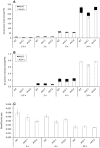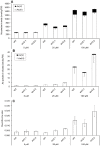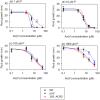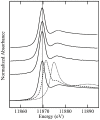Knocking out ACR2 does not affect arsenic redox status in Arabidopsis thaliana: implications for as detoxification and accumulation in plants
- PMID: 22879969
- PMCID: PMC3412857
- DOI: 10.1371/journal.pone.0042408
Knocking out ACR2 does not affect arsenic redox status in Arabidopsis thaliana: implications for as detoxification and accumulation in plants
Abstract
Many plant species are able to reduce arsenate to arsenite efficiently, which is an important step allowing detoxification of As through either efflux of arsenite or complexation with thiol compounds. It has been suggested that this reduction is catalyzed by ACR2, a plant homologue of the yeast arsenate reductase ScACR2. Silencing of AtACR2 was reported to result in As hyperaccumulation in the shoots of Arabidopsis thaliana. However, no information of the in vivo As speciation has been reported. Here, we investigated the effect of AtACR2 knockout or overexpression on As speciation, arsenite efflux from roots and As accumulation in shoots. T-DNA insertion lines, overexpression lines and wild-type (WT) plants were exposed to different concentrations of arsenate for different periods, and As speciation in plants and arsenite efflux were determined using HPLC-ICP-MS. There were no significant differences in As speciation between different lines, with arsenite accounting for >90% of the total extractable As in both roots and shoots. Arsenite efflux to the external medium represented on average 77% of the arsenate taken up during 6 h exposure, but there were no significant differences between WT and mutants or overexpression lines. Accumulation of As in the shoots was also unaffected by AtACR2 knockout or overexpression. Additionally, after exposure to arsenate, the yeast (Saccharomyces cerevisiae) strain with ScACR2 deleted showed similar As speciation as the WT with arsenite-thiol complexes being the predominant species. Our results suggest the existence of multiple pathways of arsenate reduction in plants and yeast.
Conflict of interest statement
Figures







References
-
- Brammer H, Ravenscroft P (2009) Arsenic in groundwater: A threat to sustainable agriculture in South and South-east Asia. Environment International 35: 647–654. - PubMed
-
- Panaullah GM, Alam T, Hossain MB, Loeppert RH, Lauren JG, et al. (2009) Arsenic toxicity to rice (Oryza sativa L.) in Bangladesh. Plant and Soil 317: 31–39.
-
- Meharg AA, Rahman M (2003) Arsenic contamination of Bangladesh paddy field soils: Implications for rice contribution to arsenic consumption. Environmental Science & Technology 37: 229–234. - PubMed
-
- Williams PN, Islam MR, Adomako EE, Raab A, Hossain SA, et al. (2006) Increase in rice grain arsenic for regions of Bangladesh irrigating paddies with elevated arsenic in groundwaters. Environmental Science & Technology 40: 4903–4908. - PubMed
-
- Zhao FJ, McGrath SP, Meharg AA (2010) Arsenic as a food-chain contaminant: mechanisms of plant uptake and metabolism and mitigation strategies. Annual Review of Plant Biology 61: 535–559. - PubMed
Publication types
MeSH terms
Substances
Grants and funding
LinkOut - more resources
Full Text Sources
Medical
Molecular Biology Databases
Research Materials

